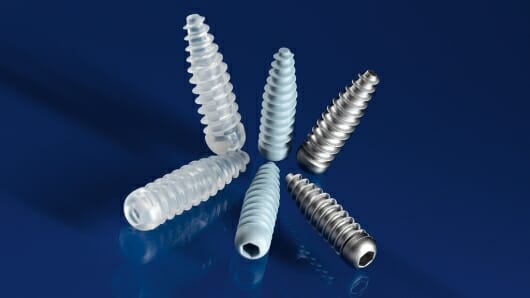Medical grade polymers are growing in popularity for implantable applications as they offer performance advantages over metal components. In addition, implantable additives, such as those that provide visibility under x-ray or stimulate bone growth are also being utilized to increase polymer performance and improve patient outcomes.
Implantable polymers can be categorized based on anticipated duration in the body and range from short-term (<30 days), bioresorbable, long-term (>30 days) to permanent. Materials used within these applications are subject to a higher degree of control pertaining to manufacturing, packaging, storage and FDA submission.

Permanent / Metal Replacement
Metal materials including stainless steel and titanium have a history of use in permanent implants for orthopedic, cardiovascular and spinal applications. However, bio-durable polymers including Polyetherkeytone (PEEK), and Polyethylene (HDPE, UHMWPE) are becoming increasingly popular.
PEEK is a biostable plastic offering high strength and stiffness plus excellent toughness and fatigue resistance. In addition, PEEK has the closest modulus to cortical bone of any biomaterial, making it desirable for spinal cages and implants.
HDPE and UHMWPE are perhaps the most common polymers used in hip, knee and shoulder reconstruction. These materials can be reinforced with carbon fiber or cross linked for enhanced mechanical strength.
Bioresorbable Polymers
Bioresorbable polymers are metabolized by the human body after implantation and include polylactide (PLA), polyglycolide (PGA) and copolymers of PLA/PGA for orthopedic screws and anchors. Phase pure β Tricalcium phosphate (TCP) is an osteoconductive and biocompatible additive that can be melt blended with these materials for the stimulation of bone growth.

